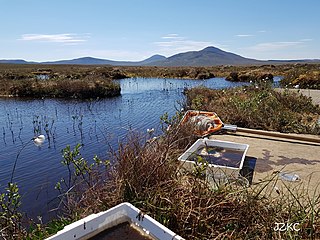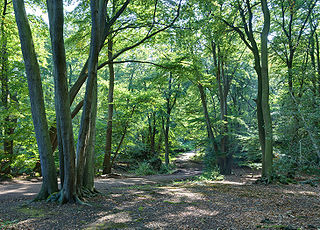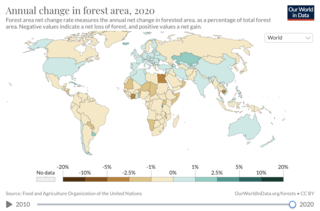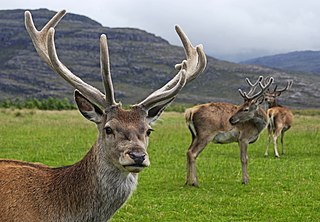Related Research Articles

Reforestation is the natural or intentional restocking of existing forests and woodlands (forestation) that have been depleted, usually through deforestation, but also after clearcutting.
The Forestry Commission is a non-ministerial government department responsible for the management of publicly owned forests and the regulation of both public and private forestry in England.

In the United Kingdom, an ancient woodland is a woodland that has existed continuously since 1600 or before in England, Wales and Northern Ireland. Planting of woodland was uncommon before those dates, so a wood present in 1600 is likely to have developed naturally.

The Caledonian Forest is the ancient (old-growth) temperate forest of Scotland. The forest today is a reduced-extent version of the pre-human-settlement forest, existing in several dozen remnant areas.

Afforestation is the establishment of a forest or stand of trees (forestation) in an area where there was no previous tree cover. Many government and non-governmental organizations directly engage in afforestation programs to create forests and increase carbon capture. Afforestation is an increasingly sought-after method to fight climate concerns, as it is known to increase the soil quality and organic carbon levels into the soil, avoiding desertification. Afforestation is mainly done for conservational and commercial purposes.
- The rate of net forest loss decreased substantially over the period 1990–2020 due to a reduction in deforestation in some countries, plus increases in forest area in others through afforestation and the natural expansion of forests. A 2019 study of the global potential for tree restoration showed that there is space for at least 9 million km2 of new forests worldwide, which is a 25% increase from current conditions. This forested area could store up to 205 gigatons of carbon or 25% of the atmosphere's current carbon pool by reducing CO2 in the atmosphere and introducing more O2.

The Flow Country is a large, rolling expanse of peatland and wetland area of Caithness and Sutherland in the North of Scotland. It is the largest expanse of blanket bog in Europe, and covers about 4,000 km2 (1,500 sq mi). It is an area of deep peat, dotted with bog pools and a very important habitat for wildlife, as well as climate change mitigation. As peat is largely made up of the remains of plants, which are themselves made up of carbon, it locks up large stores of carbon for thousands of years. This carbon would otherwise be released to the atmosphere and contribute to global warming. The Flow Country is currently being considered as a potential World Heritage Site on account of its unparalleled blanket bog habitat. It could be part of the Global Peatlands Initiative.

Glen Affric is a glen south-west of the village of Cannich in the Highland region of Scotland, some 15 miles west of Loch Ness. The River Affric runs along its length, passing through Loch Affric and Loch Beinn a' Mheadhoin. A minor public road reaches as far as the end of Loch Beinn a' Mheadhoin, but beyond that point only rough tracks and footpaths continue along the glen.

Biomass is plant-based material used as a fuel for heat or electricity production. It can be in the form of wood, wood residues, energy crops, agricultural residues, and waste from industry, farms, and households. Some people use the terms biomass and biofuel interchangeably, while others consider biofuel to be a liquid or gaseous fuel used for transportation, as defined by government authorities in the US and EU. The European Union's Joint Research Centre defines solid biofuel as raw or processed organic matter of biological origin used for energy, such as firewood, wood chips, and wood pellets.

Forestry in India is a significant rural industry and a major environmental resource. India is one of the ten most forest-rich countries of the world. Together, India and 9 other countries account for 67 percent of total forest area of the world. India's forest cover grew at 0.20% annually over 1990–2000, and has grown at the rate of 0.7% per year over 2000–2010, after decades where forest degradation was a matter of serious concern.

The United Kingdom, being in the British Isles, is ideal for tree growth, thanks to its mild winters, plentiful rainfall, fertile soil and hill-sheltered topography. Growth rates for broadleaved (hardwood) trees exceed those of mainland Europe, while conifer (softwood) growth rates are three times those of Sweden and five times those of Finland. In the absence of people, much of Great Britain would be covered with mature oaks, except for Scotland. Although conditions for forestry are good, trees do face damage threats arising from fungi, parasites and pests. The development of afforestation and the production and supply of timber in Wales come under Natural Resources Wales, as set out in the Forestry Act 1967.

Climate change in Scotland is causing a range of impacts on Scotland, and its mitigation and adaptation is a matter for the devolved Scottish Parliament. Climate change has already changed timings of spring events such as leaf unfolding, bird migration and egg-laying. Severe effects are likely to occur on biodiversity.

Glenurquhart or Glen Urquhart is a glen running to the west of the village of Drumnadrochit in the Highland council area of Scotland.

Scotland is ideal for tree growth, thanks to its mild winters, plentiful rainfall, fertile soil and hill-sheltered topography. As of 2019 about 18.5% of the country was wooded. Although this figure is well below the European Union (EU) average of 43%, it represents a significant increase compared to the figure of 100 years previously: in 1919 it was estimated that only 5% of the country's total land area was covered in forest. The Scottish Government's Draft Climate Change Plan has set an aim of increasing coverage to 21% of Scotland by 2032, with the rate of afforestation rising to 15,000 hectares per year by 2024.

Dunwich Forest is an area of forest and lowland heath around 1 mile (1.6 km) north-west of the village of Dunwich in the English county of Suffolk. The forest covers an area of approximately 9 square kilometres and was originally planted by the Forestry Commission. The forest is within the Suffolk Coast and Heaths Area of Outstanding Natural Beauty and is in the area known as the Suffolk Sandlings. South of the reserve is the National Trust property of Dunwich Heath, one of the largest remaining areas of lowland heath on the Suffolk coast, and the RSPB reserve at Minsmere. To the north and east of the forest are Dingle Marshes, part of the Suffolk Coast National Nature Reserve.
The Woodland Carbon Code is the UK standard for afforestation projects for climate change mitigation. It provides independent validation and verification and assurance about the levels of carbon sequestration from woodland creation projects and their contribution to climate change mitigation.

Deforestation is a primary contributor to climate change. Land use changes, especially in the form of deforestation, are the second largest anthropogenic source of atmospheric carbon dioxide emissions, after fossil fuel combustion. Greenhouse gases are emitted during combustion of forest biomass and decomposition of remaining plant material and soil carbon. Global models and national greenhouse gas inventories give similar results for deforestation emissions. As of 2019, deforestation is responsible for about 11% of global greenhouse gas emissions. Carbon emissions from tropical deforestation are accelerating. Growing forests are a carbon sink with additional potential to mitigate the effects of climate change. Some of the effects of climate change, such as more wildfires, may increase deforestation. Deforestation comes in many forms: wildfire, agricultural clearcutting, livestock ranching, and logging for timber, among others. The vast majority of agricultural activity resulting in deforestation is subsidized by government tax revenue. Forests cover 31% of the land area on Earth and annually 75,700 square kilometers of the forest is lost. According to the World Resources Institute, there was a 12% increase in the loss of primary tropical forests from 2019 to 2020. Mass deforestation continues to threaten tropical forests, their biodiversity, and the ecosystem services they provide. The main area of concern of deforestation is in tropical rain forests since they are home to the majority of the planet's biodiversity.

Continuous cover forestry is an approach to the sustainable management of forests whereby forest stands are maintained in a permanently irregular structure, which is created and sustained through the selection and harvesting of individual trees. The term "continuous cover forestry" does not equate exactly to any one particular silvicultural system, but is typified by selection systems. For example coppice with standards and Reiniger's Target diameter harvesting are also continuous cover forestry. Different existing forest stands may require different silvicultural interventions to achieve a continuously productive irregular structure.

Compensatory Afforestation (CA) is defined as the process of afforestation, and associated regeneration activities are done to compensate for destroyed forest land that has been diverted to non-forest activities. In this context, non-forest activities mean the clearing of a forest or just a small part for the following purposes: Coffee cultivation, rubber, tea, plants with oil, medicinal plants or gardening crops. This may be for the purpose of personal use or for business use—or any other purpose other than the reforestation of the forest.

This article gives an overview of the structure of environmental and cultural conservation in Scotland, a constituent country of the United Kingdom.

The Great Northumberland Forest is a proposed new forest in the north of England. Announced in September 2019, it is intended that up to a million trees will be planted between 2020 and 2024.
References
- ↑ Smout, T C; MacDonald, R; Watson, Fiona (2007). A History of the Native Woodlands of Scotland 1500–1920. Edinburgh University Press. ISBN 978-0-7486-3294-7.
- ↑ "Woodland expansion across Scotland". NatureScot . Retrieved November 29, 2019.
- 1 2 "Draft Climate Change Plan: The draft third report on policies and proposals 2017-2032" (PDF). Government of Scotland. January 2017.
- ↑ Lucas, Oliver. "The Forestry Commission". Landscape Design . 150: 10–11.
- ↑ Stewart, Philip (January 1985). "British forestry policy: Time for a change?". Land Use Policy. 2 (1): 16–29. doi:10.1016/0264-8377(85)90051-1.
- ↑ Warren, Charles (January 2000). "'Birds, bogs and forestry' revisited: The significance of the flow country controversy". Scottish Geographical Journal. 116 (4): 315–337. doi:10.1080/00369220018737103. ISSN 1470-2541. S2CID 128815023.
- ↑ Forestry Commission. The Policy for Broadleaved Woodlands. Edinburgh: Forestry Commission, 1985.
- ↑ Oosthoek, Jan (2013). Conquering the Highlands : a history of the afforestation of the Scottish uplands. ANU E Press. ISBN 978-1-922144-79-9. OCLC 825017080.
- ↑ Newton, Adrian C.; Stirling, Muir; Crowell, Michelle (January 2001). "Current approaches to native woodland restoration in Scotland". Botanical Journal of Scotland. 53 (2): 169–195. doi:10.1080/03746600108685021. ISSN 1359-4869. S2CID 83852406.
- ↑ Forestry Commission. Great Britain and England annual Report and Accounts2003-2004. Edinburgh : FC, 2004.
- ↑ Scottish Executive. The Scottish Forestry Strategy. Edinburgh : Forest Commission Scotland, 2006.
- ↑ Keane, Kevin (June 11, 2019). "Greenhouse gas emissions target missed in Scotland". BBC News . Retrieved December 2, 2019.
- ↑ Keane, Kevin (June 13, 2019). "Scotland meets tree planting target for first time". BBC News . Retrieved December 2, 2019.
- ↑ Scotland Forestry. Forestry Commission Scotland no longer exists. https://scotland.forestry.gov.uk. [Online] April 1, 2019. [Cited: December 1, 2019.] https://scotland.forestry.gov.uk.